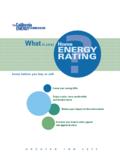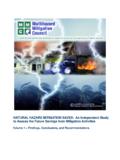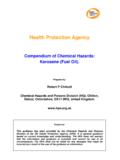Transcription of Using Properties to Manage Flammable Liquid Hazards
1 Using Physical and Chemical Properties To Manage Flammable Liquid Hazards [R Roberts, Roberts & Roberts, February 5, 2011]. INTRODUCTION. This is a general guidance for Using physical, chemical, thermal, and electrical Properties to identify and control Hazards of Flammable liquids and their vapors. Five motor fuels (hydrogen, compressed natural gas (CNG), propane, methanol, ethanol, no. 2 diesel, and biodiesel) are used as examples. Properties of these materials are listed in Table Data in Table 1 are available within various web pages on the internet and in published sources. Some of the data is difficult to locate and even more difficult to interpret and verify. Flame speed is an example of this difficulty. Some sources indicate the flame speed of methanol is greater than that for unleaded gasoline; others sources state the reverse. Still others report that small additions of methanol increase the flame speed of gasoline.
2 It is likely that all are correct, depending on circumstances. The purpose of collecting and comparing data for different fuels is to determine and compare the severity of potential consequences: fires, explosions, and toxic plumes. Consequence analysis is an emerging science and does not provide exact results. Flame speeds of both methanol and gasoline are sufficiently close to one another that the difference does not affect first order explosion overpressure and fire ball heat flux calculations. Both gasoline and methanol are known to BLEVE in non-bulk containers, and tank trucks, tanker rail cars, and above and below ground tank storage. Vapors of both gasoline and methanol are explosive in confined spaces, and form vapor plumes when unconfined. If consequence severity must be determined at a second order level, then the user should verify that data in Table 1 is adequate for the desired level or precision and accuracy when calculating overpressure and radiant heat flux hazard zones.
3 Proprietary consequence analysis software contains what the software providers have judged to be appropriate parameter values. It is good practice to confirm software modeling results with hand calculations to verify that results provided by the software are reasonable. 1. Information and data are collected from a variety of sources including various web pages. Data in some sources conflicts with data in other sources. Effort has been made to use reliable sources; however, no responsibility is taken for correctness, accuracy, or errors in Table 1 information. 1. A word of caution, values presented in Table 1 are determined in a controlled laboratory environment, and therefore characterize a narrow range of conditions. Test results for pure materials are not representative of fuel blends, contaminated materials, complications associated with switch loading, and Properties at elevated temperature and pressure which are typical of a process environment.
4 FLAM MABLE LIQIUIDS. OSHA and NFPA classify liquids as Flammable and combustible. Each of these designations is divided into sub-classes based on selected physical and chemical Properties . These Properties are indicators of conditions at which ignition and combustion occur. Liquids are assigned to classes based on the values of identifiable and measurable Properties ; each class contains materials whose Properties are within specified ranges. For example, class IA Flammable liquids have flash point temperatures below 73 oF and boiling point temperatures below 100 oF ( , n- pentane); class IB Flammable liquids are defined as having flash point temperatures less than 73. o F and boiling point temperatures at or above 100 oF ( , methanol, ethanol, unleaded gasoline);. class IC Flammable liquids have flash point temperatures at or above 73 oF, and boiling point temperatures below 100 oF ( , turpentine).
5 This guidance focuses on IB Flammable liquids, because this class contains three widely-used motor fuels which are transported, handled and stored in large bulk quantities. To an extent, fire Hazards that characterize a particular flammability class are common to all of the materials within that class. Class IB Flammable liquids include motor fuels, solvents, reactants and feed stocks. Benzene, toluene, acetone and alcohols are examples of IB class solvents and reactants. Knowing that a Liquid is assigned to a particular flammability class is useful; however in order to adequately control material Hazards and implement an effective safety program, it is important to understand the differences in the Hazards posed by specific hydrocarbons2 and chemical compounds within each group. Hazard severity is assessed within the context of the Properties of the Liquid , the circumstances in which the Liquid is being used, and the manner in which the chemical is handled (transported, stored, blended, and processed).
6 Generalized statements such as handle and store methanol in a manner similar to the way in which gasoline is handled and stored are useful as far as they go. They set the stage for what must be done. However guidance based solely on flammability class seldom goes far enough, or is specific enough to allow selection of a suite of measures which provide multiple independent 2. Hydrocarbons are understood to be liquids which boil over a range of temperatures; chemical compounds are understood to boil at a single characteristic boiling temperature. 2. layers of protection. In general, between 3 and 8 levels of protection should be established for each chemical. Some levels of protection will safeguard multiple Hazards . Other safeguards are necessarily specific to a particular hazard. No two hydrocarbons, fuels, or chemicals have identical Properties .
7 It is therefore essential that users implement safeguards based on Properties specific to their materials, to their specific circumstances, and to their particular use. Guidance provided by NFPA, ASME, API, NEC, NACE, ISA, IEEE, and other groups cab be construed as generally-accepted good practices.'. The intent is to provide a minimum standard of care. Depending on users' circumstances and a company's aversion to the risk of accidental release, addition measures beyond those indicated in codes and regulations may be appropriate. Some regulations, such as those for occasional vehicular transport of non-bulk quantities of methanol and gasoline must be obtained from local fire authorities. There is little or no specific guidance for personal use of methanol for backyard manufacture of biodiesel in national standards such as NFPA. The necessity of Using material- specific parameters to assess and control Hazards is illustrated by three examples.
8 The examples are selected to characterize the range of methanol users from private individuals making biodiesel 25-50 gallons in a batch. to oil refineries, international chemical manufacturers, shipping companies, and terminal operators. 1. Boutique-Users: Handling and Transfer of gasoline/methanol in non-bulk containers: Gasoline is not classified as a toxic material. There are minimal consequences associated with inhaling gasoline vapor when mouth-siphoning gasoline. However, Liquid methanol is toxic in tea-spoon-sized amounts and toxic effects of methanol vapor are cumulative within the body. Methanol must not be ingested or inhaled. If siphoning transfer of methanol is warranted, then use a siphon pump, wear PPE, and provide spill containment. Methanol siphoning must never be mouth-initiated. Static accumulation is another consideration associated with siphoning, pouring, and other forms of package transfer.
9 The electrical conductivity of gasoline is 25 pS/m, and that of low sulfur diesel fuel is 5 pS/m. Conductivity of gasoline and diesel is so low that these fuels accumulate static charge during pumping, filtering, and splash transfer operations. Grounding and bonding during Liquid transfer is a necessary protection against static discharge when handling all Flammable liquids. This is especially true for liquids which have conductivities less than 50. pS/M. Liquids with conductivity > 50 pS/m accumulate static charge. By comparison, the electrical conductivity of methanol is in the range of 300,000 pS/m. Methanol, like water is a polar material, and has relatively high conductivity compared to non- polar materials such as gasoline and diesel fuel. Conductivity above 50 pS/M does not alleviate the necessity of bonding and grounding. Rather, the high conductivity of methanol indicates that accumulation of static charge within the Liquid is less likely and ignition by static discharge is not 3.
10 Expected to occur except in abnormal circumstances. Two examples of consequences of failing to bond and ground in abnormal circumstances during methanol transfer are as follows: March 2006, Green Star Products, Inc., of Bakersfield, California reported a serious "fire incident" late last month at the site of ABF's biodiesel plant. According to GSPI, the accident occurred outside of the plant building when, during a transfer of methanol, a small spill ignited. While the ignition source remains unknown, GSPI expects it was likely caused by static electricity. ABF suffered a total loss of the building and equipment . No plant personnel were injured during the blaze. 2008, Canada, during abnormal transfer of methanol from one tank truck to a second tank truck, the methanol ignited, causing one fatality destroying the trucks, and damaging a load out facility.






